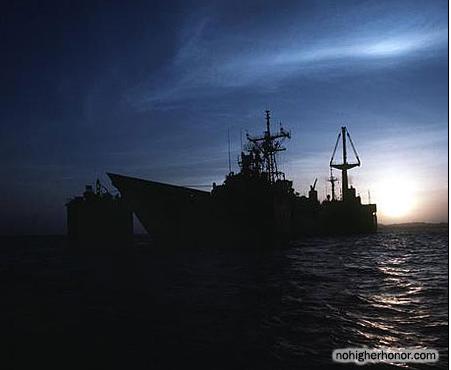
20 years on the 15th, one of the best stories of seamanship and leadership that we have seen at sea in, well, 20 years.
Rinn knew something was happening the moment the ship began to back down. He had commanded this ship since it was an inanimate pile of steel on a Maine riverbank, and felt every vibration as if it were his own body. He answered the phone, and in almost the same movement was out the door and up the ladder to the bridge.The real story takes place from there. She is still around too, though mines have gone nowhere - though by our actions you would think they have.
Through the door to the bridge wing, the floating black forms were clearly visible less than half a mile away. Three of them, lined up.
Those are mines, Rinn thought.
In a minefield, the only clear path to safety was the wake. The captain was an excellent shiphandler, by instinct and by years at sea, but backing a frigate wasn't easy. It was hydrodynamically akin to throwing a paper airplane backwards. Rinn gripped the rail and gazed aft to the pale white stripe that stretched back to clear water. The ship began to creep backward, powered by a pair of electric outboard motors customarily used for docking in safe harbor. Moments went by.
We're going to get out, he told himself.
There were those, later, who imagined they heard a scrape of metal on metal.
The explosion grabbed the frigate and shook it from stem to stern. The ship flexed, flipping Gibson backward out of his chair. Superhot gases rushed through a hole in the hull, setting fires at the ship's very core. A wall of seawater followed within seconds, ripping open fuel tanks and flooding the engineroom.
Far above, a ball of flame erupted from the ship's stack, and fiery chunks of debris rained down on the deck. With reflexes imbued by thousands of hours of drills, sailors rushed to pull hoses from bulkhead racks. But when they pulled the levers on the heavy brass nozzles, a mere trickle came out. Somewhere under their feet, something was very wrong.
It would take Rinn and his crew hours to add up all the clues, but the news they gathered early on wasn't good. The main engineroom and another capacious engineering space were inundated with oil-slicked water, and a third compartment was filling rapidly. Lose that one, and the frigate would likely plunge to the bottom of the Gulf.
The Samuel B. Roberts was flooding, on fire, surrounded by sharks and sea snakes, alone in a minefield in a sea at war. Its crew was fighting for their lives. But they faced the battle well-prepared, well-led, and with a sturdy ship beneath their feet. The outcome of the next few hours would, in no small part, be determined by events that began many years before.
If you haven't already, follow the link and get the book.
Hat tip ShawnP.









No comments:
Post a Comment